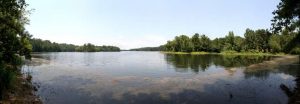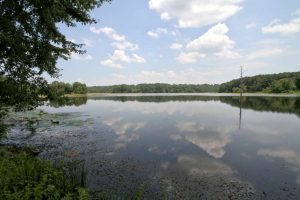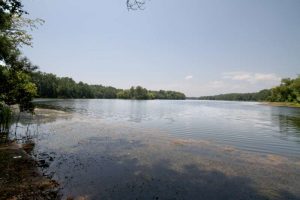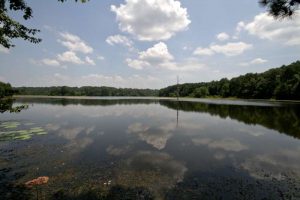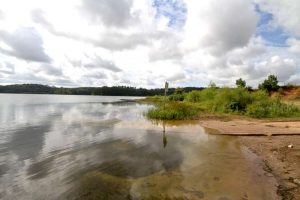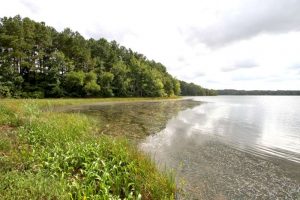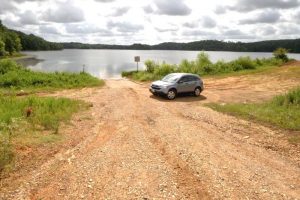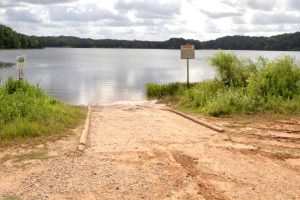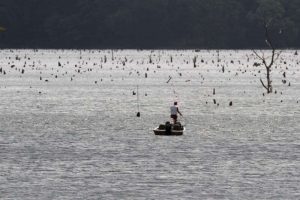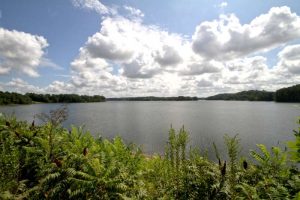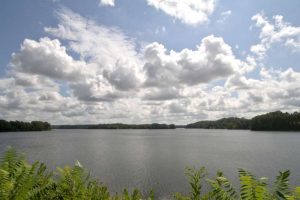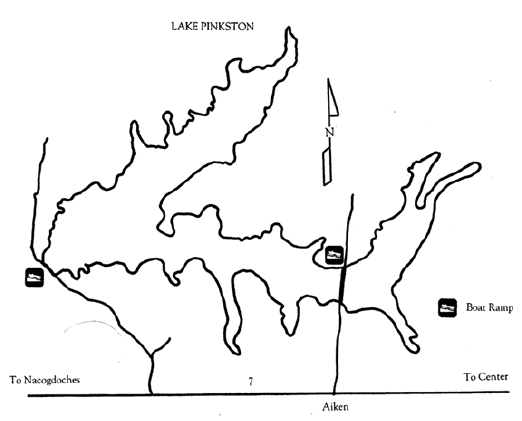Lake Pinkston
~ Please click any image for enlargement ~
Lake Pinkston is a 560-acre reservoir built by the City of Center in 1976. The lake is located 10 miles west of Center on State Highway 7 just north of the small community of Akin – on County Road 1211. County Road 1234 connects to County Road 1510 which meanders back to the lake and crosses the dam.
Recreational facilities are very limited and include only 2 boat ramps. No camping, picknicking, or sanitary facilities are provided and no marinas are present at the lake. However, Lake Pinkston is located in a beautiful area of East Texas and can provide a delightful experience away from the usual crowds. Most of the timber in the reservoir was not removed and provides an abundance of fish habitat, but also makes boating hazardous. Boaters must use extreme caution on the lake to avoid the numerous logs and stumps. Some bank fishing access is available along the country roads located at the dam and at the boat ramp on the upper portion of the lake.
The county road on the upper portion crosses the reservoir and isolates over 100 acres of water that is connected to the main lake only by a large culvert under the road. Small boats can go through the culvert or be launched off the county road to allow access to this portion of the lake. The limited access reduces fishing pressure to this area.
The deep, clear waters of Lake Pinkston offer excellent fishing opportunities for largemouth bass, crappie, sunfishes, and catfishes. However, special fishing regulations apply to largemouth bass and fishermen should consult the Texas Recreational Fishing Guide for current length limits and bag limits. No trotlines are permitted in the lake and no water skiing is allowed.
Photos from the East end of the lake off County Road 1211
Fishing at Lake Pinkston
Largemouth Bass
Largemouth bass fishing is the main attraction on this lake. Florida largemouth bass were stocked in the reservoir when it was impounded and have produced an excellent trophy bass fishery that produced one state record bass (16.90 pounds) in 1986. The lake regularly produces bass over 10 pounds in addition to excellent fishing for bass in the 2 to 5 pound range. As with most lakes, the best fishing is usually from February through May during the spawning season. However, night fishing during the summer can be quite productive and although winter fishing can be slow, deepwater structure can produce some excellent fish. Habitat in the reservoir includes not only the flooded timber, but also large areas of submerged aquatic vegetation. During the summer and early fall, the lake stratifies and a strong thermocline is present between 12 and 15 feet so fishing should be restricted to water less than 15 feet deep. Best lures include plastic worms, jigs, spinner baits, and crank baits. During the winter, spoons jigged over deep water structure produce good catches.
Crappie
Crappie fishing is best during March through May following the spawning season. Good areas for crappie include the outside edge of the submerged vegetation beds in 10 to 12 feet of water. December and January are also good months to fish for crappie when they are congregated in large schools along the creek channels in water from 20 to 30 feet deep. Both black and white crappie are found in Lake Pinkston. Black crappie are the most abundant, but the white crappie are larger, reaching weights of 2+ pounds. Most fishermen use minnows for bait, but small jigs and spinners also work very well.
Sunfishes
The most overlooked fishery in the lake is for bluegill and redear sunfishes. The high density population of largemouth bass keeps the sunfish population from becoming stunted and allows these fish to reach quality sizes often exceeding one pound. Other sunfishes present include longear, redbreast, and warmouth. Best areas for these fish are the outside edges of submerged vegetation beds and along creek channels in 10 to 12 feet of water. Popular baits include earthworms, crickets, smalljigs, and spinners. The larger specimens of sunfishes are usually caught in deeper water. Redear sunfishes can be caught during April and May when they are congregated in spawning areas in water about 3 to 4 feet deep. Small crawfish are excellent baits for redear sunfish. During the summer, anglers should fish their baits on or near the bottom in 10 to 12 feet of water. If no fish are caught within 15 minutes, move to another area until the fish are located.
Catfishes
Channel catfish and flathead catfish are present, but only in small numbers. Since no trotlines are allowed in Lake Pinkston, fishing methods are restricted to rod and reel, throwlines, and jug lines. Flathead catfish are best taken using live baits, such as sunfishes or bullhead catfish. Channel catfish can be taken on a wide variety of baits including shad, minnows, worms, cut bait, shrimp, stink baits, or any number of other baits. Best areas to fish for channel catfish are areas clear of submerged aquatic vegetation in 12 to 1S feet ofwater. Flathead catfish can usually be found along creek channels in 12 to 15 feet ofwater.
Tailrace Fishing
During periods of high water levels, overflow into the tailrace stream attracts good numbers of crappie and largemouth bass. This tailrace is very small and has limited access, but excellent bank fishing is available for the angler willing to take the trouble to try this area.
General Information
Information on fishing Lake Pinkston can be obtained from bait and tackle shops or taxidermists in Center or Nacogdoches. Additional information can be obtained from the Texas Parks and Wildlife Department, Inland Fisheries office in Jasper. Consult your Texas Recreational Fishing Guide for current fishing regulations. Remember to handle your fish carefully and practice catch and release, particularly with larger fish. If you do not plan to mount a trophy bass, release it quickly and gentiy. If you want to take fish home to eat, then take the smaller fish and release the larger ones for someone else to enjoy. It takes the care and assistance of all fishermen to maintain the high quality of fishing in Lake Pinkston.





